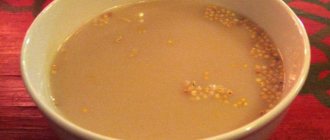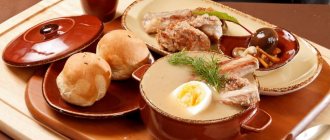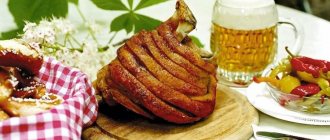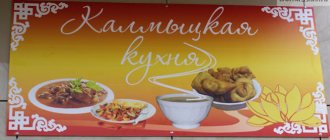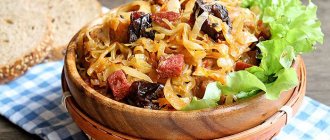In Egypt, the cuisine interested me the least, but this was only at the beginning. After all, I wanted to move to this country, and therefore such tourist “little things” as tasty treats and traditional dishes did not particularly impress me. But the more I was in the country, the more cities I visited, the more I realized that Egypt, alas, does not in any way resemble a dream country, and that living here at the level of European comfort will not help, well, absolutely nothing - neither big money nor good friends, or a beach with the sea and beautiful fish.
Somewhere in the middle of my trip, I realized that while I was going back, it wouldn’t hurt for me to get acquainted with the cuisine of Egypt, so that I would at least have something to tell my friends about. Otherwise, all my reviews about Egypt boil down to the fact that a third world country is a third world country, and you can’t do anything with it.
1) Kushari
Kushari is considered the national vegetarian dish of Egypt and consists of pasta with tomato sauce, which is mixed with rice, lentils, caramelized onions, garlic and chickpeas. Due to the fact that this dish has 4 sources of carbohydrates, it has become a very popular lunch dish and can be bought right on the streets of Egypt for the last 100 years. Interestingly, kushari is not of Egyptian origin; some of its ingredients were brought here by British soldiers in the 19th century. Pasta was imported from Italy, tomatoes from Latin America, and rice from Asia. However, it was the Egyptians who came up with the idea of mixing everything together to create a very satisfying, tasty vegetarian dish.
Beverages
Since Egypt is a hot country, drinks play almost the main role in it. After bottled water (this is the water recommended for drinking in Egypt, and it is available for sale everywhere), most likely, hibiscus will be the first and most popular drink you try in this country. Hotels often offer it as a compliment to guests upon arrival.
What is hibiscus
Hibiscus is a tea made from the petals of a flower called hibiscus (another name is Sudanese rose). It is believed that the best hibiscus in the world grows in Sudan and Upper Egypt, and hibiscus in these countries is the most delicious of all. This drink has a slightly tart taste and a rich red color. It is consumed hot and chilled. Sometimes sugar is added. Arabs consider hibiscus not only very tasty, but also a healing drink.
Other drinks
Another national drink is Asyr Asab. This is cane juice, and it is considered national in many countries where sugar cane grows (India, Vietnam, Pakistan, Thailand), only the name differs. It tastes very sweet and its natural color is yellow-green. Therefore, to improve the color and taste, it is often mixed with various fruit juices. To avoid poisoning, it is best to buy this drink in a can. It is no less tasty in packaging, and you can also bring it to friends as a gift.
Popular non-alcoholic drinks include kahwa (thick, strong coffee) and mint tea.
Egyptians have an ambivalent attitude towards alcohol. Egypt, as you know, is a Muslim country, and Islamic norms prohibit drinking alcohol. But alcoholic drinks are available for sale, especially in megacities, tourist centers and resort towns. During the holy holiday of Ramadan, alcohol is sold only in hotels and bars for foreigners (sometimes it is necessary to present a passport). In Egypt, it is officially legal to drink alcohol once you reach the age of 21.
2) Ful medames
This dish is made from beans, served with vegetable oil, garlic and lemon juice. It has gained great popularity in Egypt. Ful medames has been prepared since the time of the Twelfth Dynasty pharaohs. The word "medames" is translated from the Coptic language as "buried." The name comes from how this dish was originally prepared: a pot of beans was buried in hot coals and sand. Today, ful medames is complemented by a variety of other foods, such as butter, tomato sauce, tahini, fried or boiled eggs and pastrami. However, traditionally it should be eaten on its own along with bread.
Egyptian cuisine. Dessert
Egyptian cuisine.
Rice-based sweets For dessert, it is best to go to one of the countless pastry shops, do some shopping, sit by the sea and admire the sunset, try mahalabiya - an extremely sweet rice pudding with pistachio nuts or (and) basima, basbousa and harissa - delicious semolina and nut cakes , almonds, coconut and honey. Be sure to stock up on paper handkerchiefs and water, because honey will drip onto your hands...
Then coffee at the nearest ahle (cafe), where in addition to cardamom-flavored mocha or tea with fresh mint leaves, you can try kamun, a hot drink made from lemon juice, cumin and salt. Perfectly quenches thirst!
Egyptian cuisine. Fragrant mint tea
4) Mulukiya
Mulukia is made from the leaves of the jute plant, which grows in eastern and northern Africa. In Egypt, this dish is prepared like this: jute leaves, garlic, coriander are cut and boiled along with meat, such as chicken, beef or rabbit. Served with Egyptian bread or rice. Interestingly, in different parts of the country, mulukiya is prepared differently, for example, in cities that are located by the sea, such as Alexandria and Port Said, it is made with a fish or shrimp base. At the end of the 10th century, the dish was banned by Caliph Abu Ali al-Hakim bi-Amri Allah, but even after the ban was lifted, some religious sects still refuse to eat this dish in memory of this caliph.
Gastronomic traditions
Ultimately, discovering the national cuisine of Egypt, often so spicy and unconventional, became my main goal during several weeks of stay in different cities. I want to say right away that the recipes for this or that traditional dish do not differ much from city to city, but greatly from the specific place of preparation. Usually in local canteens everything is spicier and fattier, while in restaurants everything is drier, small and familiar to European tastes, even if it is truly Arab food.
I tried a huge number of dishes in Egypt, without even knowing their names, and only then got around to writing everything down in one article, so that someone else could also plunge into this amazingly colorful abyss of Arab cuisine.
5) Fesik
Fesik is a traditional Egyptian dish that is only served during the festival of Sham el-Nessim, which has been celebrated in the spring since the time of the pharaohs. This dish is fermented, salted and dried mullet. In the process of preparing this dish, the fish is dried in the sun and then salted. It is usually prepared by a special person called fasakani. Due to the complex cooking process, fesik can be poisoned if it is not prepared correctly. Fish is usually stored in thick glass jars that are tightly closed, as the smell is quite strong. This dish is usually served with Egyptian bread, chopped onions and lemons.
Where to eat?
Public catering in the Arab state is developed not just well, but remarkably. There is everything here: from small street stalls to fashionable restaurants. We will not consider fast food chains - they are practically no different from Russian ones. And if possible, you should not eat at street stalls - many of them are unsanitary, and hardly anyone would want to play the “lottery” with their own stomach.
We offer you an overview of good restaurants with delicious Arabic cuisine and affordable prices: one for each popular Egyptian resort.
Abou El Sid in Cairo
Abou El Sid in Cairo
Both visitors and locals love to eat here, which is an excellent recommendation. When you come to this restaurant, be sure to try molokeya - this thick green soup is a specialty here.
Among other interesting treats, we should mention stuffed pigeon – Abou El Sid’s chefs prepare it truly masterfully.
Abou El Sid in Cairo
The establishment is located in Zamalek - this is a cozy and fairly calm area of the Egyptian capital. But the advantages of the restaurant are not limited to the convenient location alone - the prices are also very pleasing. For only $25-35 per person you can enjoy delicious traditional cuisine.
Abu Ashraf in Alexandria
Abu Ashraf Restaurant
The hallmark of this popular Alexandria restaurant is the delicious grilled fish, the delicious aroma of which is felt far beyond the pale. The staff at Abu Ashraf are friendly, polite and courteous. The waiters will be happy to help you if you cannot choose the dishes you want from the rich menu here.
Abu Ashraf Restaurant
The restaurant has it - the fish chosen by the client is weighed and cooked right in front of him. Various soups are also very tasty here.
Africa in Luxor
Africa Restaurant
After you've had your fill of exploring various memorable places, be sure to stop by the Africa restaurant. It is best to do this in the evening, when the heat in the area subsides and the sun is approaching sunset - this way you can comfortably sit at a table on the roof of the establishment and admire the Nile while tasting delicious dishes of traditional Egyptian cuisine.
Africa Restaurant
The local chefs prepare food in accordance with local traditions: in clay pots and over an open fire. Recommendations include meat with rice and vegetables and cold wine. For the rest, be guided by your preferences. If possible, visit Africa more often and try different dishes - affordable prices allow you to do this.
Dananeer in Sharm El Sheikh
Dananeer in Sharm El Sheikh
One of the most famous resort restaurants. There are local and international dishes. The main emphasis is on fish and a variety of seafood. Specialties: steak with spicy garlic butter, lamb chops and baked grouper.
Important! Book a table at Dananeer in advance - there are almost never empty seats here.
Felfela in Hurghada
Felfela in Hurghada
Wonderful restaurant on the coast. The spacious terrace of the establishment offers a beautiful view of the neighboring island.
Egyptian cuisine is prepared very tasty here and offered to guests at fairly low prices. Meat lovers should definitely order the mixed grill - this is a complex dish of kofta, veal and lamb. Served with a delicious salad and fries.
7) Halva
Halva is a popular sweet dish from the Middle East, which is loved not only in all Mediterranean countries, but throughout the world. In Egypt, halva is prepared from sesame paste and given completely different shapes. You can often find a variety of additives in halva, including pistachios, pine nuts and almonds. Halva is eaten at any time of the day, and can also be added as the main ingredient to many other dishes, for example, sakalans - a mixture of halva, honey and whipped cream. Interestingly, halva is one of the few Egyptian dishes that can withstand high temperatures without spoiling, and it does not require any special conditions.
Food culture in Egypt
The local population has long been accustomed to tourists and for the most part does not pay attention to their behavior at the table. But if you want to show yourself as a well-mannered person who respects local traditions, remember a few simple recommendations and follow them during your Egyptian holiday.
First of all, know: Arabs love not only to eat tasty and hearty food, but also to smoke. However, smoking is allowed in almost every restaurant here. Even finding an establishment with a non-smoking room is quite difficult, and telling an Egyptian not to smoke at the table is considered impolite and disrespectful.
Secondly, be prepared: you will be offered bread with almost every dish. They just love him very much in Egypt. Even if you don't eat baked goods at all, don't be surprised when someone in the local population starts using bread as cutlery. But don’t worry: spoons, forks and knives are also present in local restaurants.
Egyptian flatbreads Aish Baladi
Thirdly, in Egypt it is customary for the person invited to dinner to insist on paying the bill. Of course, no one will force you to pay for everyone, but you shouldn’t sit and be silent either - it’s impolite. And no one will immediately agree with your proposal. Usually, each participant in the meal insists that he is the one who must pay the bill, as a result of which the dispute over this issue often lasts longer than the dinner itself. The most persistent one usually “wins.”
Egypt is not only a lot of beautiful beaches, interesting sights and fashionable hotels. The local cuisine is also full of surprises and unusual discoveries. You learned about the most delicious Arabic dishes and the places where they are best prepared.
Bon appetit!
Table. Popular restaurants in Egyptian resorts
| Restaurant name | Address | Average bill per person |
| Abou El Sid | Cairo 157 26th of July St | Up to $20-25 |
| Abu Ashraf | Alexandria, Anfushi, Safar Pasha st., 28 | Up to $20-25 |
| Africa | Luxor, West Bank, Gezira st. | Up to $20-25 |
| Dananeer | Hussein Salem, Qesm Sharm Ash Sheikh, South Sinai, Egypt | $25-50 |
| Felfela | Sheraton Rd., Sekalla, Hurghada, Egypt | Up to $20-25 |
 Dukkah
Dukkah
Dukkah is an Egyptian dish that is used as a side dish and can be eaten with Egyptian flatbreads or raw vegetables such as tomatoes and cucumbers. The dish is a mixture of herbs, nuts and seasonings such as mint, salt, sesame, coriander and cumin. Dukkah is usually prepared at home and each family has its own variations, but it can also be purchased from herbalists. The name dukkah comes from the Arabic word for pounding, which refers to the process of its preparation. This dish is not particularly well known outside of Egypt, although it has recently gained popularity in Australia.
Egyptian cuisine. Breakfast
Egyptian cuisine.
Koshari No matter how many pounds an Egyptian has in his pocket, breakfast without these specialties would have no meaning for him.
Koshari is a mixture of pasta, lentils, rice and chickpeas, covered in a thick layer of rich tomato sauce (you can also smell cumin, fried onions and garlic). Egyptians often start their day with this dish. Koshari is the Egyptian brother (sister?) of Indian curry, a very similar dish but with the addition of fried vegetables and very hot spices.
Curry, on the other hand, has close family ties to Scottish kedgeree (with added fish), introduced to India long ago by British troops. Another cousin of black bean koshari is extremely popular in the Caribbean, called hopping john, a dish that likely originated there thanks to Indian immigrants.
Koshari are sold in bars, where cooks scurry around in front of customers, sequentially pouring portions into plastic cups. Although the pace of their work is incredible, there is often a queue in front of the counters.
Koshari is very cheap - a large portion for two costs 5 Egyptian pounds (about 24 rubles). We get two sauces: hot chili and garlic, based on wine vinegar. Some people top the koshari with tahina, a sesame sauce.
An equally popular breakfast item is ful medames (just ful), a cooked variety of African beans with olive oil, fresh lime juice, plenty of cumin, coriander leaves and an egg at the end. This is a very old dish originally from Sudan. It is always eaten with hot flatbreads, sometimes with tahini, tomatoes and hot sauce.
Ful are usually sold from portable carts, the arrival of which is announced by the owners with shrill bells. These bells are a characteristic sound in Egyptian cities, especially late at night, because very often you buy breakfast before going to bed to warm it up in the morning before going to work. A large portion costs 1.5–2 pounds (about 10 rubles). This extremely simple and satisfying dish will satisfy your hunger until lunch.
9) Kunafa
Kunafa is an Egyptian sweet made from very thin pasta made from kadaif dough. The origins of this dish are shrouded in mystery and can be seen in medieval cookbooks from Egypt, Lebanon and Turkey, but the origins of this sweet remain unclear. Kunafa is made from very thin noodles. Spread the batter in a thin layer onto the hot pan until golden and crisp. Then it is mixed with oil, butter or vegetable, and the filling of nuts, whipped cream, and cream is wrapped in it. It is then baked and served with fruit syrup.
Useful tips for tourists
- In Egyptian restaurants, visitors are served lemon slices in addition to main courses. Don't refuse such a treat. Some local dishes may be too heavy for a tourist to digest. Lemon normalizes the gastrointestinal tract and destroys bacteria
- Before going to the beach, eat vegetable salads, dishes made from grains and legumes. This food contains a lot of slow carbohydrates that take a long time to digest. Slow carbohydrates will provide you with the necessary energy for swimming in the sea and outdoor games
- When the mercury on the thermometer rises above 30 °C, do not try to quench your thirst with cold drinks. After them you want to drink even more, and your throat may become inflamed due to hypothermia. It is better to order hot tea at one of the local restaurants, which normalizes the water-salt balance. Drinking 1-2 cups is enough to not feel thirsty for several hours.
10) Brynza gibna domiati
Gibna Domyati is a soft white cheese that is made in the city of Dumyat in northern Egypt. Usually this cheese is made from buffalo milk, but sometimes cow's milk is added to the mixture. This is the most popular type of cheese and is added to many Egyptian dishes, including sambusak (fried thin flatbread with cheese) or mesh (tomato or cheese sauce). Gibna domiati is aged in large cans for 1 to 3 years before it reaches the Egyptian table. Many Egyptian families are proud of the number of cheese tins they have accumulated over time. They say that the longer the cheese is aged, the tastier it is.
Egyptian cuisine. Fish and seafood
Egyptian cuisine.
Fish Denis The two seas and their gifts did not go unnoticed by the Egyptians. Various types of fish (including the colorful ones you'll become friends with while snorkeling and diving in the Red Sea) are available in Hurghada restaurants. Shrimp, clams, squid, lobster, crab - fried and grilled - are much cheaper than in other parts of the world.
The most delicious fish in the Red Sea are sea bass and yellowfin tuna.
Fish restaurants in Hurghada: Star Fish in Sakalla (halfway between Sakalla Square and Arosa).
The best fish and seafood is served on Mahmya Beach. Mahmya has been famous for many years for its delicious, but at the same time the most expensive menu in the city. The beach restaurant is open from sunset (previously for beach visitors) until 23.30 - last order time. The minimum charge is £250 per person. They only offer alcoholic beer and wine, but you can bring your own bottle, such as whiskey, for which you will pay an additional 200 LE. Children under 12 years old are not allowed after 22.00.
Baqlawa | Baklava
The Egyptian version of the Turkish sweet is definitely worth trying. It contains a little less sweet syrup, so it is not cloying, and is usually served in the form of small rolls. Baklava is rightfully traditionally included in the list of national desserts of Egypt and other Arab countries. Many Middle Eastern countries prepare it in their own way. The filling in the Egyptian version is most often not a nut mixture, but a sweet cream based on cream. In this case, the treat is sprinkled with pistachios and raisins.
Bring a couple of boxes of baklava from Egypt as a gift to your loved ones. It is also sold by weight, but carrying such sweets will be less convenient.
